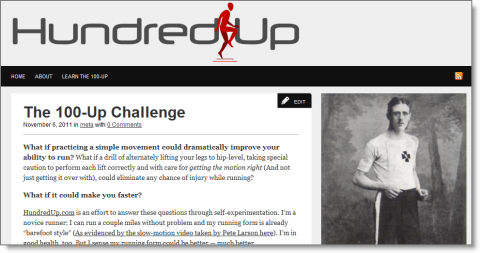This past weekend was the NYC Marathon. And unless you’ve been sleeping under a pair of Nikes rock, you likely caught Born to Run author Christopher McDougall’s latest piece in the NYTimes, The Once and Future Way to Run. If you haven’t read it, check it out as it speaks to the importance of proper running form above all else (including footwear). It’s well worth the read.
And if you were paying attention to McDougall’s write-up, you also probably noticed a heavy mention of a century old training technique developed by W.G. George called the Hundred-Up — a drill basically consisting of alternately lifting your legs while standing in place. It seems that George, the fastest “miler” of the 19th century having set a record of 4:12.75 back in 1886, cited practicing the 100-Up exercise (something he had to do out of necessity lacking free time to train) as responsible for his running success.
Interesting, eh?
And what you might have missed (I did on first pass) in the online version of the article is Chris McDougall and actor/director Peter Sarsgaard demonstrating the “major” and “minor” versions of the hundred-up. Watch the video:
Could a drill you could practice virtually anywhere be the key to better, even possibly best, running form? And if W.G. George’s 100-Up could make you a better runner — teach you how to run fast and injury free — wouldn’t you want to learn it? The possibility of mastering the 100-Up so fascinated me that I dedicated a chunk of my weekend to creating a challenge around the exercise but I need your help.
I built a site:
And I created a challenge. I want to see if this thing works.
What’s the challenge?
Well, you need to hop over to HundredUp.com and find out (or if you just want to read more about the Hundred Up drill, I’ve cobbled together some of the original writings from W.G. George on the 100-Up).
Big H/T to Ted_S for your research efforts and of course Chris McDougall for bringing this to my attention!


9 replies on “Walter (W.G.) George and Learning to Run with the 100-Up”
I’m so glad you set up the 100 Up site! After reading the article the other day I went on an online search for 100 ups and came up empty! Thanks for helping us out!
Thanks for compiling the 100-Up writings and such. I too was curious about its merits. Now I have a better idea how to do the drill. Cheers!
I really like the 100 Up drill though I don’t think it solves everything magically. It nicely reinforces proper body posture with good foot strike. However, it does nothing for rhythm and for teaching a relaxed style. I’ve have incorporated it into my bag of tricks.
Thanks for write up, I’m always looking for something new to try to and it’s simple enough to do while at the office when a need break. After watching the video does anyone know what Peter has on his feet.
Eric, I think they’re Brancas – http://www.runbranca.com/.
Funny thing, I was just running with a friend a few days ago, he was running in Chucks and was f—ed up by how great the impact on his body was. So I told him he should try forefoot-running, he did, and a few metres later he told me completely amazed how awesome that is and that he doesn’t feel the impact on his knees and body at all right now. So we ran a bit, and now his calves hurt. He wants to run so badly due to the increase of fun forefoot-running gives him, but I told him to wait a few days (or longer, just as the body tells him).
It’s really simple. Just by running barefoot in front of their nose all the time way faster than anybody I know, I transformed my father to Lunarstars (Nike things, no idea what they are exactly called; better than ‘nothing’ ;-)) and a friend to forefoot-running. Hopefully, the climbing people I know will transform to barefoot-climbing as well, seeing how much better it is – that would be great. But I guess, there isn’t much hope there. Ever seen climbing-shoes? Running-shoes are gold compared to these. 😉
Basically, what I’m saying is: When you’re no long-time-runner, just started, you will realize that heel-strike-running is bad for your body, because your body tells you – it’s screams every time you hit the ground with your heel. And then, forefoot-running isn’t hard to learn at all. You just have to run barefoot or with almost no shoe in a way that your body has no feel of impact on the ground but a feel of touching the ground, gliding gently over it and leaving it then as it were. That’s all there is to it.
Eric, Peter is wearing the Brooks Green Silence.
Many thanks for posting the W.G. George method video. I’m one of those who can’t get his head around verbal descriptions of technique, but a few seconds of visual demo makes it all clear. Would be nice if the vid were posted on YouTube, if NYT copyright practices permit, since I don’t know how long The Times will carry the vid on its site.
I also appreciated input on the footgear the guys were wearing, since I also wondered what they were.
McDougal, although great at dramatic writing, is a terrible runner. He is always going around offering up running advice but the guys technique is downright ugly. A slow and inefficient jogger, like McDougal, is not qualified to give out advice on “the lost technique of perfect running.” I do not disagree with minimalism, but McDougal’s logic is inconsistent at best, he has no place handing out running advice.
The 100 up looks like a helpful training tool for runners who already understand what it takes to be an efficient running, it also looks like a recipe for creating a mass of bad run/joggers. The main mistake most barefoot runners make is in having a circular motion going on directly underneath their center of mass, this is inefficient. Elite runners have a circular motion going on behind them, once the leg has come forward ahead of the center of mass inefficiency starts and a sloppy bouncy running technique, like that of McDougals, starts.
McDougal needs to let other runners know that he is not a good runner, and that the advice that he is handing out will only get other runners to an equally poor level of running. He should also stop with the barefoot nonsense, I know that statement will not sit well with most of crowd on this blog, but at some point running barefoot is just silly. Even the great Bikila would have opted for some shoes if they had some in his size. Most competitive runners can kick their shoes off and beat the pants of off the 5 fingers crowd, and all competitive runners recognize that in order to stay injury free, and to be competitive, shoes with padding are a HUGE benefit. That’s not to say that proper running technique and mastery is not important, they are essential.